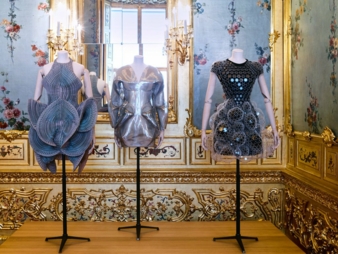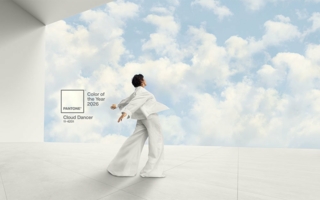22/08/2017 – Exhibition — auf Deutsch lesen
The Vulgar – Fashion Redefined
This spring, the exhibition “The Vulgar – Fashion Redefined” at Prince Eugene’s Winterpalais in Vienna tested the limits of “good” taste.
Conceived by fashion curator Judith Clark and psychoanalyst Adam Philipps, the exhibition takes literary definitions of “the vulgar” and its embodiment in fashion as a starting point. Against the backdrop of the opulent Baroque rooms of the palace and organised into ten themes (e.g. “Showing Off”, “Extreme Bodies”, “The New Baroque”), the display includes extraordinary examples of historical fashion, iconic creations by Christian Dior, Elsa Schiaparelli, André Courrèges as well as visions of contemporary designers such as Gareth Pugh, Walter van Beirendonck, Viktor & Rolf, Martin Margiela and others.
Mme Grès’ divine dresses with elegant drapery befitting a Goddess and Iris van Herpens’ alien creations eliciting spontaneous exclamations of “Mamma mia, che bello!” initially elude associations with vulgarity. Only once visitors immerse themselves in the curators’ exploration of the subject will they be able to look at them from a different point of view.
Like fashion, taste is changeable. Both rely on “mobile concepts” as defined by the predominant attitudes as well as cultural and societal etiquettes of each era. What was to be considered “good” or “bad”, pretentious, common or distasteful has always been defined by the ruling classes, the church and nobility throughout history. These notions served as a juxtaposition to distance themselves from the ordinary masses and claim certain prerogatives, thus becoming an expression of unassailable hierarchy and the boundary between the “higher” elite and the “lower” populace. As such, the term “vulgar” is a symptom of clashing and synergetic cultures and classes.
Timeless ideals of beauty and the fickle nature of (fashion) taste
The ethereal draped gowns by Mme Grès and contemporary interpretations of the timeless and classic style of the ancient world follow an eternally valid ideal of beauty, unchallenged by the prescriptive tides of fashion. Mantuas with wide overskirts popular at the English court in the 18th century, however, have not been awarded the same status. What we consider as too extreme (and thus in the realm of the vulgar) today, was then a representation of luxury. The rich and famous of the time had to develop ever new extremes of “good taste” to continuously set themselves apart from the masses, who began to threaten their accumulated wealth through technological advances and progressing colonialisation.
Extreme bodies, exposed bodies and the question of too much
How much naked skin is acceptable before it becomes vulgar? Vulgarity lies in the eye of the beholder. Fashion invokes its power in a game of self-image and manipulation. The body is vulgarised both through the presence and absence of clothing. Too much (in size, complicated intricacies, expensive materials, pompous historical quotes) conceals the body, yet its extremes draw attention to it. The same principle applies to too little clothing. On the one hand, Marc Jacobs’ use of lingerie textiles in eveningwear for Louis Vuitton has never been considered vulgar and materials like lace accentuate the design of the dress rather than having connotations of nakedness through its transparency. On the other hand, fashion items like Rudi Gernreich’s monokini (topless swimsuit), the mini skirt of the 60s and Vivienne Westwood’s and Malcolm McLaren’s punk collection featuring prints of naked breasts have been recorded in fashion history as symbols of provocation, rebellion and sexual revolution. Does this make them risqué – or vulgar? And didn’t this also apply to stays, stiff corsets worn with 18th century mantuas to achieve a fashionable wasp waist silhouette and highlight the bust by constricting and raising the breasts to bulge over the top of the corset?
As an interesting contrast, the curators also decided to examine vulgarity’s antonym: puritanism. What exaggeration, overcoming shame, indulgence, pomp and kitsch were to vulgarity, the white collar was to purity and asceticism in the 17th century. The exhibition includes exquisite and expertly hand-crafted examples with the most intricate details.
Folk art and popular culture
Designers never looked at the art and crafts of the common people as lesser or repugnant, rather it constituted a source of inspiration for them. Christian Lacroix, for instance, often incorporates or reinterprets the traditional costume of his home town Arles in the south of France in his creations. Indeed, designers today place increasing value on reviving traditional handicraft and local styles in homage to their plethora of diverse shapes and forms and in an attempt to prevent valuable traditional skills from being lost.
After popular culture claimed its place in “high art” through the emergence of pop-art, everyday culture began to receive recognition. Similarly, products that have “passed through too many hands”, i.e. mass-produced items, have brushed off their vulgar label. Even haute couture has discovered disposable products and materials for itself and transforms them into desirable objects. Luxury brands are also taking inspiration from the entertainment world: Disney’s Bambi appears on oversized prints by Givenchy, Moschino wittily twists popular slogans, and Jeremy Scott makes humorous (fashion) statements around issues such as fast food and brand piracy in the fashion industry. “Ordinary” denim has become more than “just” workwear: Nicolas Ghesquière makes it sparkle for Louis Vuitton and Miu Miu combines denim with iconic turn-of-the-century styles all the way through to the sophisticated silhouette of the 50s. Definitely no off-the-rack teen or work clothing.
The ordinary can thus be extraordinary – thanks to fashion. It also remains for fashion to answer the question: “If striving for excess becomes the norm – then what is vulgar?”
by Neli Mitewa





